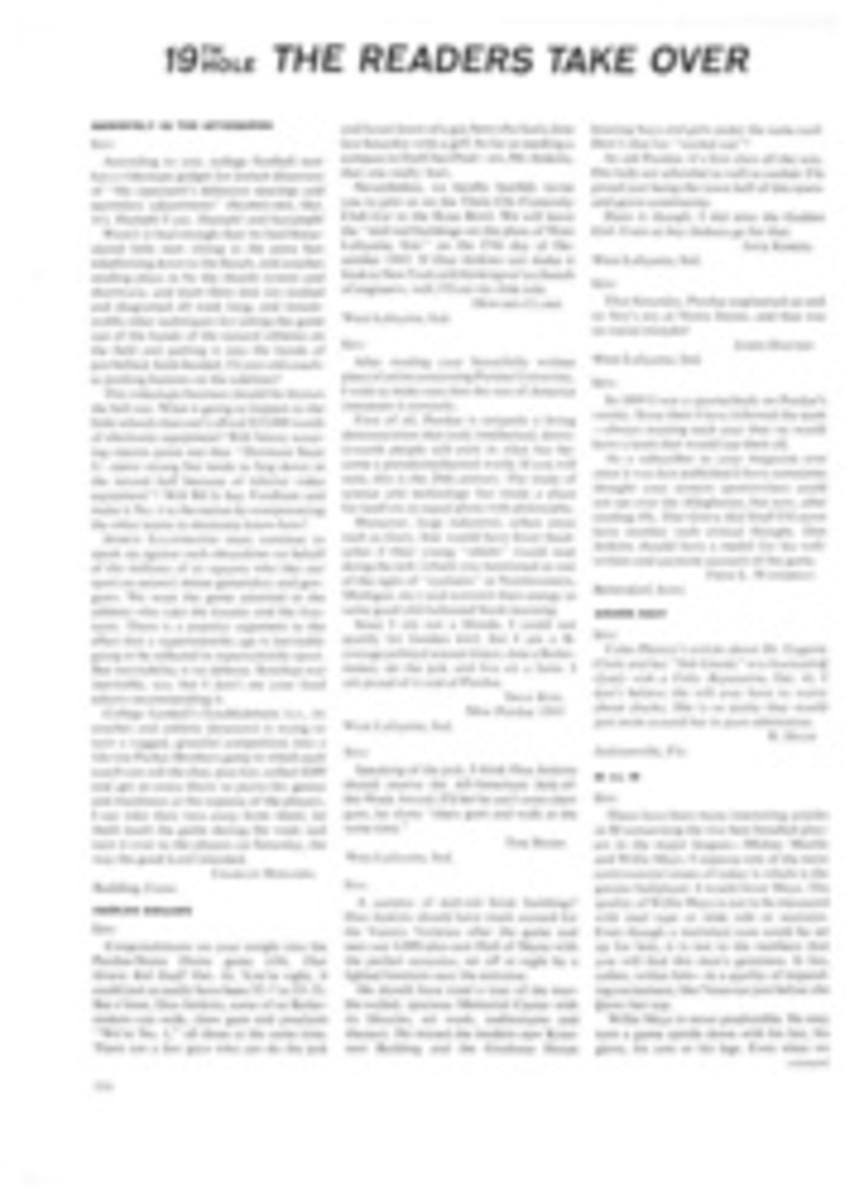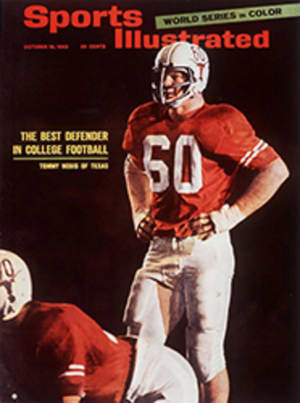
Seattle finds restless enjoyment in boating and mountains and football
Ever since the schooner Exact, out of Portland, Ore., landed off a lonely, windswept point and deposited its cargo of axes, brandy, tobacco, whiskey and 12 adults and 12 children, Seattle has held tenaciously to its boast, "the largest city in the world—for its age." It would never occur to the city's proud residents to put their slogan to a test, but the fact remains that since its founding in 1851 Seattle has grown, steadily and vigorously, to become the Pacific Northwest's unchallenged metropolis. And it always has retained its restless aura of youth, what one visitor admiringly called "a characteristic of exuberant adolescence."
Long before America's explosive discovery of do-it-yourself sport, Seattle's hardy adults ranged all over the region's abundant streams, 3,813 lakes, its challenging mountains and 193 miles of sheltered coastline. Few people paid much attention (it was scarcely noted in the press) this summer when Washington's governor, Seattleite Dan Evans, took a weekend off and scaled nearby Mt. Rainier's glacial 14,410-foot summit.
The same thing, after all, has been done many times by some of the 4,000 members of the city's Mountaineers Club, several of whom skied back down. While he might quote you the latest sales figures on Boeing's famed 707s and 727s, it would never occur to a Seattle patriot to point out that the city's mayor, 63-year-old J. D. (Dorm) Braman, is an ardent weekend skier, or that its ranking patriarch, 95-year-old banker Joshua Green, is a determined grouse hunter. It is not uncommon, either, to look out from Seattle's towering 600-foot Space Needle observation deck and see dozens of tiny fishing boats maneuvering among giant freighters in Elliott Bay. Their owners catch king salmon within walking distance of their homes.
Not that Seattle's 564,000 residents are blasé about their blessings. It's just that the city, pinched at its waist by Puget Sound on the west and Lake Washington on the east, settled between two awesome mountain ranges, the Cascades and the Olympics, is inescapably part of the outdoors. Many of Boeing's 55,000 employees, some of them deep in projects to land us on the moon, carry fly rods in their cars for a spot of stream fishing before work.
High on the list of spectator sports in Seattle and the Northwest is the fine old diversion of mountain watching. "The mountains are out today," is a favorite expression of Seattle people, who cheerfully endure the long weeks in winter when the whole area is pressed down by heavy rain clouds. No fewer than 1,118,955 travelers visited Mr. Rainier National Park this year, many of them Seattleites who drove the 85 miles for a close-up look at their mountain.
Then there is boating. It is scarcely possible to travel a single block in any one of Seattle's hilly, view-rich residential areas without seeing boats of all shapes and functions parked in garages, backyards and even on the streets themselves.
It is small wonder, then, that Seattle likes to call itself the "boating capital of America," and that it also claims the nation's largest sporting crowd—the estimated 250,000 people who annually watch the unlimited hydroplane races on Lake Washington. Ever since a Seattle designer, Ted Jones, devised the great three-point prop rider, Slo-Mo-Shun IV and won hydroplaning's highest trophy, the Gold Cup, Seattle has been fanatically devoted to its annual contests of speed by the belching, snub-nosed monsters. The hydroplane races provide a dramatic windup to Seattle's 10-day summer Seafair, a water-oriented festival of clowns, pirates and civic dignitaries parading under such grandiose titles as King Neptune and Seafair Commodore.
The pleasure of boating is itself woven into the whole fabric of Seattle's leisure life. The annual opening-day regatta, for example, is less an exercise in navigational skills than a social event. Each spring more than 1,000 boats, from putt-putts to giant diesel cruisers, come together for a parade on Lake Washington—complete with giggly costumes, dancing girls, colorful ceremonies, signal flags and prizes for best-in-show. The University of Washington, located near the water's edge, offers both credit and noncredit courses in sailing and powerboat navigation. Boats are a lively—almost a necessary—part of Washington's home football season. More than 200 craft, including several tightly packed sightseeing boats, crowd the university's specially built moorage facilities within a few hundred feet of the 55,500-seat stadium.
Denied major league baseball and professional football, Seattle lavishes its pride and bountiful affection on the Huskies—who have been to the Rose Bowl three times since 1960. Seattle is a city frantic for football. The composite Seattle citizen may carry in his wallet such minimal necessities of life as his credit cards, his fishing and hunting license, his membership in any of 12 yacht clubs, his card to one or more of eight private golf courses, his ski club membership, even his boat registration. But a choice season ticket to Husky football games is a symbol of his rank in the community. All of Washington's home games this year were virtually sold out before the season began.
To satisfy the ever-increasing demand for more seats, the university announced plans this year to build another addition to its stadium—adding 20,718 more seats and bringing the U.W. stadium to a capacity of 76,218, sixth largest college stadium in the country. Nearly 50,000 seats will be under cover—a luxury in this city where no experienced fan would be caught without umbrella or oilskins.
The Washington coach, Jim Owens, enjoys a state of near sainthood in Seattle, and when he began building a new home on Laurelhurst Point, just across the water from the U.W. stadium, students wryly observed that "Jim can now walk on water." Owens, a transplanted Oklahoman, has himself fallen captive to the Northwest. In the past two years he has become an ardent, if somewhat unstable, skier, who, like thousands of other Seattleites, takes off weekly for the nearby slopes at Snoqualmie Pass.
The most informed guesses peg the number of Greater Seattle area skiers at 170,000—a figure said to exceed the entire skiing population of New York. There may well be that many (the so-called Greater Seattle area comprises 1.1 million people), and on good weekends they flock to the Cascades' eight ski areas to the number of 45,000. No large city—with the possible exception of Munich—is so afflicted by the contagion of skiing; housewives' classes abound, mass ski schools are the rule, and the conductor of the country's largest private ski school, Outdoorsman Buzz Fiorini ("the most expensive baby-sitter in town"), enjoys a fame unrivaled by many of the city's sports celebrities.
Is Seattle really a "good" sports town? The city asks this question in sporadic bursts of self-examination, although many doubt if revenue can be raised to build an all-purpose stadium to attract "big-time" franchises. Baseball struggles fitfully along at Sicks' Stadium (doomed by a freeway in a few years), where once Seattle's fans set minor league attendance records. It is notably enthusiastic about its hockey team, the Totems (275,000 fans last winter), especially since the World's Fair of 1962 produced a modern coliseum which seats 12,300. The legacy of the fair is large along Seattle's waterfront skyline. The Space Needle restaurant and observation deck drew 782,429 visitors at $1 per ride up its swift outside elevators.
Seattle is a city that long has yearned to be taken seriously as a "major league" sports center, and it twitches defensively when such a noted visitor as Stan Musial is heard to observe, "Man, this is a long way from anyplace." But Seattle is too busy to brood over what might be called its shortcomings. There are fish to be caught, lakes to be sailed, peaks to be climbed, trails to be hiked, beaches to be combed and slopes to be skied. Seattle still has that characteristic of exuberant adolescence—and plenty of room to work it off.

